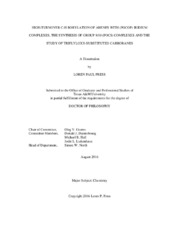| dc.contributor.advisor | Ozerov, Oleg V. | |
| dc.creator | Press, Loren Paul | |
| dc.date.accessioned | 2016-09-22T19:50:12Z | |
| dc.date.available | 2018-08-01T05:57:39Z | |
| dc.date.created | 2016-08 | |
| dc.date.issued | 2016-08-04 | |
| dc.date.submitted | August 2016 | |
| dc.identifier.uri | https://hdl.handle.net/1969.1/158080 | |
| dc.description.abstract | Over the last century, transition metal-catalyzed C-H functionalization has emerged as one of the most important topics in synthetic chemistry. One type of C-H functionalization, known as C-H borylation, generates organoboron reagents directly from hydrocarbon substrates. The synthetic utility of organoboron compounds is well established and numerous systems have been developed for the catalytic C-H borylation of alkyl and aromatic substrates since the reaction was first conceived over 20 years ago, yet catalysts that support high TONs remain limited to a handful of examples. Here we present highly active POCOP iridium complexes for the catalytic C-H borylation of arenes. In favorable cases, TONs exceeding 10,000 have been observed. The synthesis and isolation of multiple complexes potentially relevant to catalysis permitted examination of several key elementary reactions. We found C-H activation at Ir(I) here is in contrast to the olefin-free catalysis with state-of-the-art Ir complexes supported by neutral bidentate ligands, where the C-H activating step is understood to involve trivalent Ir-boryl intermediates.
Next, we investigated the stoichiometric reactivity of a (POCOP)Ir(boryl)2 complex with various small molecules under thermolytic conditions. Transition metalboryl complexes are ubiquitous in the literature and have been identified as key intermediates in several critical chemical transformations including C-H borylation and hydroborylation chemistries. The (POCOP)Ir(boryl)2 complex was found to undergo several stoichiometric transformations including reduction of CO2 to CO, 1,2- diborylation of ethylene and the selective protonation of one boryl ligand.
The synthesis and characterization of novel POCS pincer complexes of nickel, palladium and iridium are described. The modular design of the POCS pincer ligand allowed the exploration of monomeric and bridging ligand designs akin to PNN and PCN complexes.
The selective B-H functionalization of the mono-anionic carborane [HCB11H11]^– with one or three triflyloxy (OTf) groups is described. The mono-triflyloxy substituted carborane can be halogenated to give pentabromo and decachloro derivatives with preservation of the B–OTf linkage. The use of [HCB11Cl10OTf]^– as a weakly coordinating anion is demonstrated. | en |
| dc.format.mimetype | application/pdf | |
| dc.language.iso | en | |
| dc.subject | C-H functionalization | en |
| dc.subject | C-H activation | en |
| dc.subject | borylation | en |
| dc.subject | POCOP | en |
| dc.subject | iridium | en |
| dc.subject | POCS | en |
| dc.subject | triflyloxy | en |
| dc.subject | carboranes | en |
| dc.subject | weakly coordinating anions | en |
| dc.title | High-Turnover C-H Borylation of Arenes with (POCOP) Iridium Complexes, The Synthesis of Group 9/10 (POCS) Complexes and the Study of Triflyloxy-Substituted Carboranes | en |
| dc.type | Thesis | en |
| thesis.degree.department | Chemistry | en |
| thesis.degree.discipline | Chemistry | en |
| thesis.degree.grantor | Texas A & M University | en |
| thesis.degree.name | Doctor of Philosophy | en |
| thesis.degree.level | Doctoral | en |
| dc.contributor.committeeMember | Darensbourg, Donald J. | |
| dc.contributor.committeeMember | Hall, Michael B. | |
| dc.contributor.committeeMember | Lutkenhaus, Jodie L. | |
| dc.type.material | text | en |
| dc.date.updated | 2016-09-22T19:50:12Z | |
| local.embargo.terms | 2018-08-01 | |
| local.etdauthor.orcid | 0000-0002-1242-5837 | |


